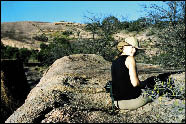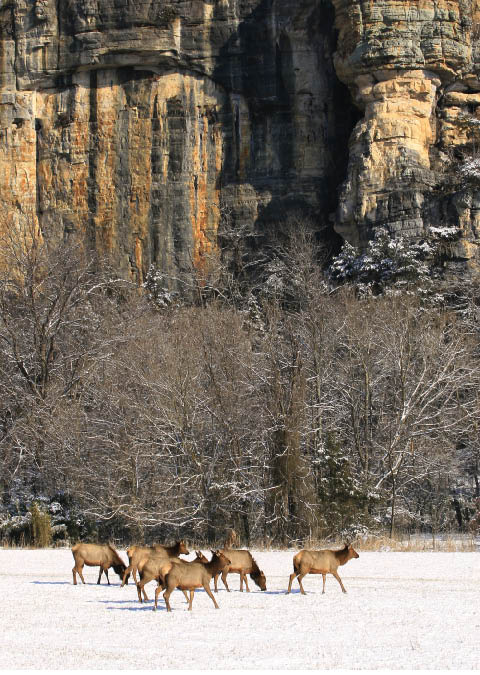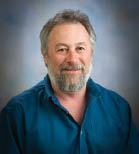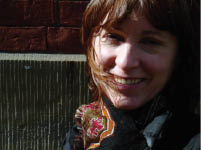Thoreau's Legacy (9 page)
Authors: Richard Hayes

One Acre at a Time
Richard Baker
LIVING IN IOWA, WHICH HAS THE MOST ALTERED landscape of any state, I appreciate Aldo Leopold’s statement about living in a world of wounds. All around us I see the effects of human use and neglect: endless monocultures of corn or soybeans, the loss of native plant communities to invasive species, intensive soil erosion and gullies, and stream pollution, which contributes to the Gulf of Mexico’s dead zone. Global warming will only magnify these problems.
Eight years ago I had the good fortune to move out into the country, to 125 acres of woods, overgrown savannas, ponds, and fields.
It was then that I
saw a chance
to make a difference.
Leopold said that the first step in intelligent tinkering is to find all the pieces. Historical records helped me determine what the vegetation and landscape were like prior to European settlement. Our area had been a mosaic of prairie on the uplands, forest along the Cedar River, and oak savanna in
between, with a scattering of springs and wet places. This mix
had formed a very stable landscape with little runoff and erosion. My wife, Deb, and I decided that our best legacy would be to return the land to this pattern, restoring where we could and starting from scratch where that was necessary. This strategy will produce stable plant communities and landscapes even in the face of global warming.
In 2000 we planted a diverse mix of prairie species, such as compass plants and prairie blazingstar, on fourteen acres, the largest flat upland area on the property. In addition, we dammed the upper end of several steep valleys suffering from severe erosion. The dams allowed four small wetlands to form, which we planted with lovely local wetland plants, including wild iris, queen of the prairie, and arrowhead. Runoff and gully formation have virtually stopped, because the prairie sod retains so much moisture, and the wetlands act as holding ponds. Even the floods of 2008 had few adverse effects.
Aerial photographs dating back to the 1940s and 1950s showed some beautiful oak savannas, but these areas, left unmanaged for sixty years, became overgrown with tall trees. Eight years ago I began burning the understory and also cut many of the fifty- to sixty-year-old trees, leaving the open-grown savanna oaks. Some savanna understory plants are returning, and visitors are charmed by the beauty of this restoration.
It is a constant struggle to keep a handful of nonnative invasive species, like garlic mustard, autumn olive, and honeysuckle, from taking over the whole landscape. On the positive side, we are solving a number of problems, preserving our natural heritage, and preparing well for any future changes. The long walks I take every day convince me that I’m doing the right thing. Seeing the diversity and beauty of the prairies, savannas, and woodlands and of the birds, butterflies, dragonflies, frogs, and other wildlife gives us great joy. We have found most of the missing pieces of the mosaic, and paradise lost is becoming paradise regained.

Richard Baker
is a professor emeritus of geoscience at the University of Iowa. He and his wife, Deb, and two dogs live in the woods overlooking the Cedar River in eastern Iowa.
Steel Creek
Amanda Keen-Zebert
I don’t know how big a difference we can make or how long it will take for the climate to respond to
our changes in behavior.
I do all the little things in the hope that decades from now I will be able to go to Steel Creek on a cold winter day, hear the
elks’ hooves crunch in the snow,
and delight in romantic dreams of wilderness and great-grandchildren.

Amanda Keen-Zebert,
a native of northwest Arkansas, holds a Ph.D. in environmental geography. She lives with her husband, Konah, a nature photographer, in Fayetteville, Arkansas.
Steel Creek, Buffalo National River, Arkansas.
Photo by Konah Zebert.

The Lying Sky
John Calderazzo
THE SKY IS LYING TO ME AGAIN. I’M STANDING IN MY Colorado back yard, staring up at a dazzle of stars and imagining that the air I’m breathing stretches up and away from me for hundreds or even millions of miles, until the last lonely molecule of oxygen peters out in deep space.
Of course, this isn’t true. I know that the atmosphere wraps our planet as thinly as a shell wraps an egg. But
my eye is tricked by the
transparency of air
and the immensity of the universe,
and my brain wants to follow. It’s reassuring to think that air goes on and on, just as it’s comforting to stand on a Pacific beach and assume that the crashing ocean is boundless, its amazing creatures numberless. Who wants to believe that the natural world can’t absorb, unchanged, everything we throw at it?
But then I think about Yuri Gagarin, the Soviet cosmonaut who in 1961 became the first person to fly in space. As one story goes, Gagarin looked down shortly after liftoff, saw how thin the blue skin of the atmosphere really is, and became terrified. He had never before understood the limited and fragile nature of the only home we have.
Since then writers like Rachel Carson have shown us how pulling on just one thread in the complicated fabric of biological life can yank so many others out of kilter. But it seems we need to be reminded endlessly. How else to explain the tepid attention our policymakers and citizens have, until recently, paid to climate change? Ever-mounting evidence shouts that this may be the biggest single issue facing the planet.
So why haven’t we acted? Scientific illiteracy? The fact that “Grow back the glaciers!” doesn’t sound as sexy as “Save the whales!”? Eco-fatigue? Maybe the problem is that when I stare up at Orion or an afternoon thunderhead, I can’t actually
see
anything getting warmer.
Or maybe our denial is born of an unfathomable clash of scales, as I’ve seen in people I’ve met over the years who live on the slopes of volcanoes. Refusing to leave even when the ground starts to rumble, they say,
It hasn’t erupted in 1,200 years, so why should it start now?
Well, because volcanoes grow and collapse to the planetary beat of Deep Time, which reaches far beyond human generations. Thus, while my rational mind has long accepted the proofs of global warming, a tiny part of me
still
doesn’t want to believe we puny humans are to blame.
Which is why we sometimes need to distrust gut feelings and pay attention to the bigger picture of science.
So here I am, standing in my back yard and watching an infinity of stars. And I’m thinking, The thin skin of our planet is not immune to us. The world is warming. We’ve caused it. And now, what are we going to do about it?

John Calderazzo
teaches creative writing at Colorado State University. With his wife, SueEllen Campbell, he founded and directs Changing Climates @ CSU, a lecture series in which professors talk about climate change from various academic perspectives.
The Price of Detachment
Tara Mitchell
AS A LANDSCAPE ARCHITECT, I WORK TO CREATE
landscapes of beauty and utility, shaping the land to satisfy the human eye and human needs. Yet very often I find myself restoring degraded landscapes, battling invasive plants, and seeking to preserve even the smallest of habitats—sometimes a single tree, which in its lifetime will hold thousands of birds, in whose universe millions of insects will eat and be eaten, among whose roots billions more insects, fungi, and bacteria make their home.
At a construction site, I see that the big oaks left unprotected near the work area are dead. Their naked limbs, like fingers, still reach toward the summer sun. The soil structure in the root zone has been crushed by trucks. People don’t understand that soil is a living material, but it is alive only as long as it has biological connections. Once compacted, it can no longer hold air and water or sustain microorganisms. Without access to these essential elements in the soil, a tree will die. When it dies, not only does the immediate habitat disappear, but a link in the larger habitat is broken. The invisible is altered as well as the visible: nitrogen cycles, carbon cycles, microclimates, evapotranspiration—chemical and physical changes in water, soil, and atmosphere that, taken together, make the earth more or less habitable.
A few miles down the road, I pass a gap in the forest. Acres of soil lie bare. Bulldozers, backhoes, and excavators are eating away at the earth; a stream of trucks, like ants, cart soil away. It is like seeing flesh stripped, bone exposed. On the other side of the road, the landscape stretches low and flat, covered with stores, restaurants, and parking lots. Sparsely planted trees stir in the breeze above the hot concrete. Storm drains wait to pipe away rainwater. Very little is living here, yet we unquestioningly accept the replacing of forests with these lunar landscapes.
When we can no longer read the land, we no longer see what is in front of our eyes. Despite access to ever more information, despite threats of global warming, toxic water, and eroding soils,
we continue to
close our senses
to the land.
Our iPods shut out the rustling of leaves, the quiet of snow falling. Fences, measured strips of asphalt, rectangles of lawn, reshape the native landscape. Our taste for fast food kills the forest. Like global warming, our detachment will feed upon itself: as the climate warms, we will increasingly withdraw behind air-conditioned walls.
We have chosen not to live as an integrated part of the complex ecosystem upon which we depend, but to be separate, boxing ourselves off from cradle to grave. In so doing, we have lost the ability to sense both beauty and danger. We need to change, not for what we will lose in the future, but for what we miss in the moment. The landscape will always be here, whatever form it takes. Whether it is one we can live in may no longer be up to us.

Tara Mitchell
has been a landscape architect for the Massachusetts Highway Department for ten years. She lives in Medford, Massachusetts, and enjoys painting in watercolors, writing, and tending her orchids and bonsai.
